GEORGE W. SUTTON
1927–2021
Elected in 1994
“For contributions to ballistic missile re-entry, lasers, medical devices, imaging systems, and aero-optics.”
BY EARL H. DOWELL
GEORGE WALTER SUTTON—an eminent aerospace engineer and scientist and the longest-serving editor in chief of the AIAA Journal—passed away February 13, 2021, at the age of 93. His impact on the journal and indeed on all publications of the American Institute of Aeronautics and Astronautics remains an unmatched legacy. In addition to his substantial technical contributions, he is remembered for the high standards and rigorous editorial process that he established and that have been maintained and built on by his successors. A man of firm views leavened by a dry sense of humor, his wisdom and candor continually moved AIAA publications in a more productive direction.
George Sutton was born to Jack and Pauline Sutton in Brooklyn, New York, on August 3, 1927. After attending Brooklyn Technical High School he served in the United States Merchant Marine during World War II and the Army Air Force in Okinawa through 1947. After his military service, he earned his bachelor’s degree in mechanical engineering with honors from Cornell University’s School of Engineering
__________________
This memorial was prepared with the willing and respectful help of his successors as editor in chief of the AIAA Journal: Tom I-P. Shih, since 2021; Alexander J. Smits (NAE 2011), 2015–20; Peretz P. Friedmann, 2009–14; and Elaine S. Oran (NAE 2003), 2003–08.
in 1952 and received both his master of science degree (1953), also in mechanical engineering, and doctor of philosophy in engineering and physics magna cum laude (1955) from the California Institute of Technology.
His career spanned government, the private sector, and academia. He began at General Electric in Philadelphia (1956–63), where he invented the heat protection material for hypersonic flight through the Earth’s atmosphere—enabling the first US reconnaissance satellites, as high-resolution film could be returned to Earth in a recovery vehicle. He then worked for the US Air Force Headquarters in the Pentagon (1963–65) before moving to a series of opportunities in industry, culminating with his job at Cobham Analytic Solutions as principal senior scientist for new projects and the Space Laser Project (1999–2011) and then as a consultant at Analysis and Applications, Inc. in Huntsville, Alabama. He also taught at Stanford University, the University of Pennsylvania, and the Massachusetts Institute of Technology, and authored or coauthored 130 papers, coauthored or edited 3 books, 1 and held eight patents.
A pioneer and expert in heat protection material for hypersonic flight, magnetohydrodynamics, and high-power lasers, Dr. Sutton made many significant contributions in aerospace. In addition to being the first to measure the heat transfer in the throat of a rocket nozzle, he invented the ablation heat shield material allowing safe reentry from space used by US ICBMs and early crewed spaceflight; produced the first resolved photograph of a foreign spacecraft from Air Force Maui Optical Station (AMOS) telescope in Hawaii; developed the concept design for the first high-power CO2 laser that generated 130 kW; demonstrated the small high-frequency transcutaneous energy supply for artificial hearts used by Abiomed; and developed the concept design of the SOFIA aircraft for infrared astronomy and aero-optic analysis of the airflow.
___________________
1 His books include Engineering Magnetohydrodynamics, coauthored with Arthur Sherman (McGraw-Hill, 1965), and Direct Energy Conversion (McGraw-Hill, 1966), which was translated into Japanese and Russian.
As editor in chief of the AIAA Journal, he made it clear that he did not want the journal to “be all things to all people; instead, each paper has to have some relevance to aerospace, either directly or by demonstrating a technique that could be useful in aerospace. The emphasis is on the practical for our industry, without which the journal would not exist….” Under his leadership (1968–96), the AIAA Journal disseminated an enormous amount of knowledge that nurtured and advanced aerospace engineering in its golden era, during which so many remarkable accomplishments were made.
Dr. Sutton’s accomplishments were recognized by his peers through numerous honors, beginning in 1965 when he received the Arthur S. Flemming Award for “unique contributions to the fields of heat protection of hypersonic reentry vehicles, and magnetohydrodynamic power generation.” He received the AIAA’s 1980 Thermophysics Award, 1988 Distinguished Service Award, and 2007 Plasmadynamics and Lasers Award for his pioneering work in aero-optics and in the development of high-power gas lasers, both pulsed and continuous wave, and in laser effects, and was designated an honorary fellow. In addition to his membership in the National Academy of Engineering, he was a fellow of the American Association for the Advancement of Science. The American Society of Mechanical Engineers awarded him the Nancy DeLoye Fitzroy and Roland V. Fitzroy Medal in 2015 “for distinguished contributions to the art and science of mechanical engineering including cavitation, hypersonic heat transfer, direct energy conversion, high-energy lasers and aero-optics; and for the invention of the first successful reentry ablation material and the development of the transcutaneous energy supply for artificial hearts.”
He was involved in a number of activities of the National Academies and NAE. He was appointed to the committees on Aging Avionics in Military Aircraft (2000–01), Thermionic Research and Technology (2000–01), Implications of Emerging Micro- and Nanotechnologies (2001–03), and Directed Energy Technology for Countering Indirect Weapons (2007–08), among others. And for the NAE he served on the Audit Committee
(1995–96) and Section 01 (Aerospace) Executive Committee (1998–2000) and Peer Committee (1998–2001).
George enjoyed playing classical piano, sailing, swimming, tennis, and the theater. He was also a devoted family man, treasuring opportunities to travel abroad with his wife, go sailing with his sons, and spend time with his much-loved grandchildren.
He was preceded in death—just a month earlier—by his beloved wife and best friend of 68 years, Evelyn Doris (née Kunnes) Sutton. They are survived by sons James, Charles, Richard, and Stewart, and six grandchildren.







